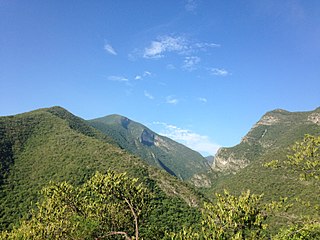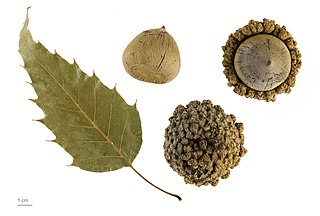
The Sierra Madre Oriental is a mountain range in northeastern Mexico. The Sierra Madre Oriental is part of the American Cordillera, a chain of mountain ranges (cordillera) that consists of an almost continuous sequence of mountain ranges that form the western "backbone" of North America, Central America, South America, and Antarctica.

The Tropical Andes is northern of the three climate-delineated parts of the Andes, the others being the Dry Andes and the Wet Andes. The Tropical Andes' area spans 1,542,644 km2 (595,618 sq mi).

Juniperus angosturana, or slender oneseed juniper, is a species of conifer in the family Cupressaceae.

Aquiloeurycea galeanae, commonly known as the Galeana false brook salamander, is a species of salamander in the family Plethodontidae. It is endemic to north-eastern Mexico and known from higher elevations in the Sierra Madre Oriental of southern Nuevo León as well as adjacent Coahuila and Tamaulipas.

The Tamaulipas pygmy owl is a species of owl in the family Strigidae. It is endemic to Mexico. This is one of the smallest owls in the world at a mean length of 13.5 cm (5.3 in). However, at 53 g (1.9 oz), it is slightly heavier than the long-whiskered owlet and the elf owl. Its natural habitat is subtropical or tropical moist montane forests.

Hombron's kingfisher or the blue-capped kingfisher is a species of bird in the family Alcedinidae endemic to the Philippines and found only on Mindanao. It is one of the most colorful kingfishers in the country having a dark blue cap and wings with rufous spots, a striped rufous belly, white chin and red bill. Its natural habitats are on the upper ranges of tropical moist lowland forest and tropical moist montane forests. It is threatened by habitat loss.

Cercocarpus traskiae, known by the common names Santa Catalina Island mountain-mahogany and Catalina mahogany, is a rare species of plant in the rose family.

Quercus benthamii is a species of oak in the family Fagaceae. It is native to the cloud forests of Central America and southern Mexico. It is threatened by habitat loss.

Quercus skinneri is a species of oak. It is found in Mexico, Guatemala, Honduras, and El Salvador. It is threatened by habitat loss.

Quercus polymorpha, the Mexican white oak, Monterrey oak or netleaf white oak, is a North American species of oak. It is widespread in Mexico, Guatemala, and Honduras, and known from a single population in the United States but widely planted as an ornamental.

Quercus castanea is a species of oak tree. It is widespread across much of Mexico, from Sonora to Chiapas, and in Guatemala, El Salvador, and Honduras.
Quercus iltisii is a species of oak tree native to western Mexico, where it is found in a small portion of Jalisco and Colima states.

Magnolia sharpii is a tree species of Magnolia from Chiapas, Mexico. It grows in wet tropical habitats.
Quercus cortesii is a species of oak native to Central America and southern Mexico.
Quercus mulleri is a rare Mexican species of oak. It has been found only in a small area of the Sierra de Miahuatlán, a sub-range of the Sierra Madre del Sur in southern Oaxaca state.
Quercus segoviensis is a species of oak native to southern Mexico and northern Central America. It is commonly known as k’antulán.
Quercus furfuracea is a species of oak native to eastern Mexico.
Quercus flocculenta is an endangered species of oak in the family Fagaceae, native to northeastern Mexico. It is endemic to the Sierra Madre Oriental of Nuevo León state.
Magnolia tamaulipana is a species of plant in the family Magnoliaceae. It is endemic to northeastern Mexico.

Quercus pringlei is a species of oak native to northeastern Mexico.













